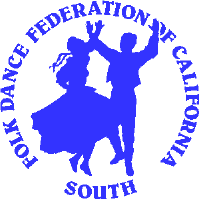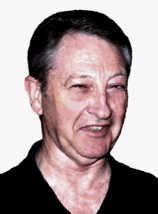
|
Folk Dance Federation of California, South, Inc.
|

|
CLICK IMAGE TO ENLARGE
 "It seems to me that there were never a more peaceful or happier people on the face of the earth than the Spanish, Mexican, and Indian people of Alta California before the American conquest. We were building towns and missions when General Washington was carrying on the war of the Revolution."
"It seems to me that there were never a more peaceful or happier people on the face of the earth than the Spanish, Mexican, and Indian people of Alta California before the American conquest. We were building towns and missions when General Washington was carrying on the war of the Revolution."
So wrote Guadalupe Vallejo about the fabled "Rancho Period" of Early California. Huge land grants supported a horse and cattle culture of immense proportions, only lightly influenced by the distant government of newly independent Mexico, of which Alta California was a part. This period survived about the same length as the American Old West – about 35 years, from 1825 to 1860 – and was just as important to California’s history.
Life in the widely scattered haciendas and villages was difficult for everyone – men, women, and children alike. As with any people for whom toil is a norm, the opportunity to pause and party was not to be taken lightly. The very nature of the Californios, their love of music and dance and finery, their generosity and hospitality – all inherited from their Spanish forbearers, quickly led to the development of a splendid form of celebration – the fandango.
The fandango was the major social event of the Californios and one was held for every possible occasion: Saint’s days, religious holidays, a new home, a visitor, a Yankee ship with goods from China and New England, a baptism, a birth, a betrothal – anything. Word of the upcoming fandango spread like wildfire and people came from miles around to share in the event – caballeros and vaqueros on horseback, señoritas and señoras in the creaking "corretas," heavy two-wheeled ox carts.
The Californios played as hard as they worked. During the day, all retired to a wooded area where food and drink were spread for an enormous picnic. The superb horsemen engaged in any number of games to display their skill. They raced each other and had great fun plucking a chicken buried in the sand up to its neck – at a full gallop. These were the vaqueros, the finest horsemen in the world and their skills laid the foundation for the American cattle industry and the American cowboy twenty years later.
As evening neared, all returned to the hacienda for the evening fandango. The women retired to the house to change into their fine dresses and velvet slippers. A sense of excitement was in the air as they all gathered at the ramada, a three-sided enclosure around a hard-packed dirt floor. The ladies took seats around the sides and the young men gathered – on horseback – at the open side of the ramada. Indian musicians sat to one side, playing violins and guitars as taught by the mission priests. Torches illuminated the scene.
When all were ready, El Tecolero stepped to the center of the ramada. He was the "master of ceremonies," an older, respected member of the community. He knew the dances, the music, the people present, and all the gossip and arrangements that were the real reason for the fandango. He would ensure that all went smoothly, that all got to dance – and that pairings of young couples were made as arranged by their parents.
All eyes are on El Tecolero as he begins to introduce the ladies present; he approaches the lady who is to be honored, usually the "doña," the lady of the house. Clapping his hands to the music, he invites her to the center of the ramada. She rises from her chair, glides to the center, executes a little dance step, and bows to the assemblage before returning to her chair. Each lady in turn is invited to the floor, each performing her little dance and casting flirtatious glances to the young men gathered to watch.
With the ladies introduced, El Tecolero calls for the first dance, usually a contradanza, a longways-set dance still popular in both Europe and America and descended from the 18th Century minuet. Couples are arranged in order of their social standing in the community, elders and guests of honor at the head in a public affirmation of the social structure. The dance figures are called by El Tecolero and executed in elegant grace by the dancers.
La Cachucha was the traditional second dance in the fandango. Translated as "my little cap," it was a term of endearment to the ladies who now proceeded to display their charms in a group dance with lovely movements of the Spanish fan and a flourish of their wide skirts. Here, also, is the opportunity to announce betrothals, as El Tecolero pairs up the young couples for all to see – an important rite of passage.
Other dances follow quickly as called by El Tecolero – jotas from Spain, soñas from Mexico, popular social dances from Europe and America. Many with ancestry in Spain performed the regional dances of Spain that were considered family heirlooms. Interestingly, the waltz became a popular dance, introduced by Don Juan Bandini of San Diego (and the most popular Tecolero and best dancer in California). Forbidden under threat of excommunication by the church for dancing it, the Californios frequently distracted the padres and waltzed without benefit of clergy. Bandini eventually became significantly responsible for the secularization of the missions because of his distaste for the authority of the mission fathers.
Far into the night they danced before finally retiring for a few hours' sleep before repeating the whole thing the next day – and night. Fandangos were known to last for several days and there are records of guests leaving in the middle of the night to continue their journey, exhausted by the experience. The women, it has been noted, appeared as fresh at the end as they had at the beginning of the festivities.
As the Californios became more numerous, the culture became more stratified – as is human nature. The wealthier families began to indulge in a less democratic form of social gathering that they called "bailes." No longer was the lowly vaquero welcome as an equal and the fandango became identified more with the lower class. Increasing numbers of Americans, mostly gold prospectors by then, took to the fandango as an outlet for their rowdy entertainments and the magical fandango of the Californios was changed forever.
Research and reconstruction of the dances, music, and costume of the period give us a startlingly strong impression of the life style and values of the Californios.
Czarnowski, Lucille; Dances of Early California; Pacific Books, Palo Alto, California, 1950.
Richards, Irmagarde; Early California; California State Department of Education, Sacramento, California, 1950.
Coronel, Antonio; Tales of Mexican California; Bellerophone Books, Santa Barbara, California, 1994.
Used with permission of the author.